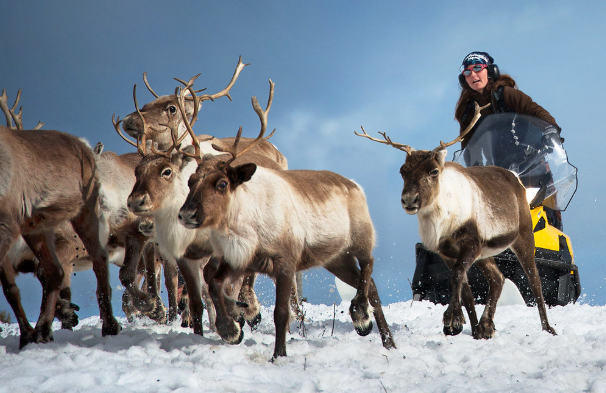By Simo Sarkki

Reindeer herding is more than a livelihood in Finland. It is a cultural cornerstone, particularly for the Indigenous Sámi people. However, with growing land-use pressures, shifting governance models, and the mounting impact of climate change, the future of this traditional practice hangs in the balance. A new study that I have been involved with, from colleagues across Finland and Germany, explores possible futures for reindeer herding using a bold and innovative approach known as “wild logic” scenarios.
Why ‘Wild Logic’?
Conventional scenario planning often falls into predictable patterns, shaped by familiar narratives and mainstream governance assumptions. The “wild logic” method offers a refreshing alternative, combining the widely used Shared Socioeconomic Pathways (SSPs) with unexpected, creative assumptions about governance. Rather than simply examining potential singular shocks (like ‘wild cards’ or ‘black swan’ events), wild logic explores entire future contexts that challenge our current ways of thinking.
In our study, the wild logic method was applied to explore reindeer herding’s future under varying socio-economic and governance conditions. The focus? How land use and governance might co-evolve, and what that means for reindeer herders in Finland.
The Context: A Landscape Under Pressure
Finland’s reindeer herding region covers nearly a third of the country and includes both Sámi and non-Sámi herders. The practice is deeply tied to natural pastures, communal knowledge, and seasonal rhythms. Yet, modern land use—mining, forestry, wind energy, conservation, and tourism—is squeezing herders into increasingly narrow spaces. Added to this are the growing threats of predators and the intensifying effects of climate change.

To grasp the full picture, we held a participatory futures workshop in Inari, Northern Finland, involving herders and related stakeholders. They mapped out the current operational environment of reindeer herding, identified key influences, and envisioned how different socio-economic futures might affect the practice and realisation of their livelihood-related dreams
Governance as the Key Variable
A central finding of the workshop was that governance, specifically how land-use decisions are made, is the most critical factor in shaping the future of herding. As such, three “wild” governance assumptions were built into the scenario analysis:
- Hierarchical Governance – Top-down decision-making where herders have minimal influence.
- Collaborative Governance – Stakeholders negotiate decisions, but power imbalances can marginalise herders.
- Affirmative Governance – Herders are recognised as rights-holders, with mechanisms in place to protect and promote their interests.
These governance types were layered onto four SSPs to create a matrix of 12 potential futures. Ten of these were deemed plausible and developed into full “wild logic” scenarios.
What Do the Scenarios Reveal?
The scenarios are not merely academic exercises—they reveal critical tensions and trade-offs that could shape life in northern Finland for decades.
For example, under SSP 1 (Sustainability):
- Hierarchical governance leads to a “Half Earth” vision where environmental goals override herder rights, evoking fears of “green colonialism”.
- Affirmative governance, however, fosters mutual respect between ecological and cultural values—a “Rights for Life” scenario that herders view favourably.
In SSP 3 (Regional Rivalry), geopolitical instability and rising prices spell hardship for herders—unless domestic food security is prioritised. In this context, affirmative governance could result in renewed recognition of reindeer meat as a strategic resource, boosting the status of herders.
Other scenarios expose internal divisions. In SSP 4 (Inequality), some herders may benefit from external recognition of “authentic” Sámi culture, while others are sidelined. And in SSP 5 (Fossil-fuelled Development), affirmative governance could lead to generous compensations but at the cost of cultural erosion, raising the thorny question: can tradition be bought?
Beyond the Arctic: Lessons in Scenario Planning
One of the paper’s key contributions is methodological. By pushing the boundaries of established scenario frameworks, the wild logic approach allows researchers and policymakers to capture nuance, imagine alternatives, and confront uncomfortable truths. The inclusion of affirmative governance is especially notable, offering a new lens through which to assess equity, rights, and resilience.
Moreover, the process was deeply participatory. Rather than impose assumptions from above, the researchers grounded their scenarios in the lived experiences and aspirations of herders in a “dreams and surprises” workshop. The resulting scenarios, while grounded in the Finnish Arctic, are relevant globally, especially for other Indigenous and local communities facing land-use conflicts.
The Road Ahead
While this research offers powerful insights, there are also limitations. The scenarios are shaped by existing SSPs, which may constrain the imaginative potential. The final scenario narratives weren’t validated in follow-up workshops with herders or policymakers—something we hope to address in future studies.
That said, the wild logic method has enormous potential. It could be applied in urban planning, climate policy, business strategy, and beyond. For reindeer herding, it offers a roadmap, however tentative, for navigating a rapidly changing landscape.
In the end, the message is clear: to secure a future for reindeer herding, land-use governance must evolve. And that evolution must begin by recognising herders not merely as stakeholders, but as rights-holders with a vital role in shaping the Arctic’s future.
The full version of the article can be read in the Journal of Land Use Science.


